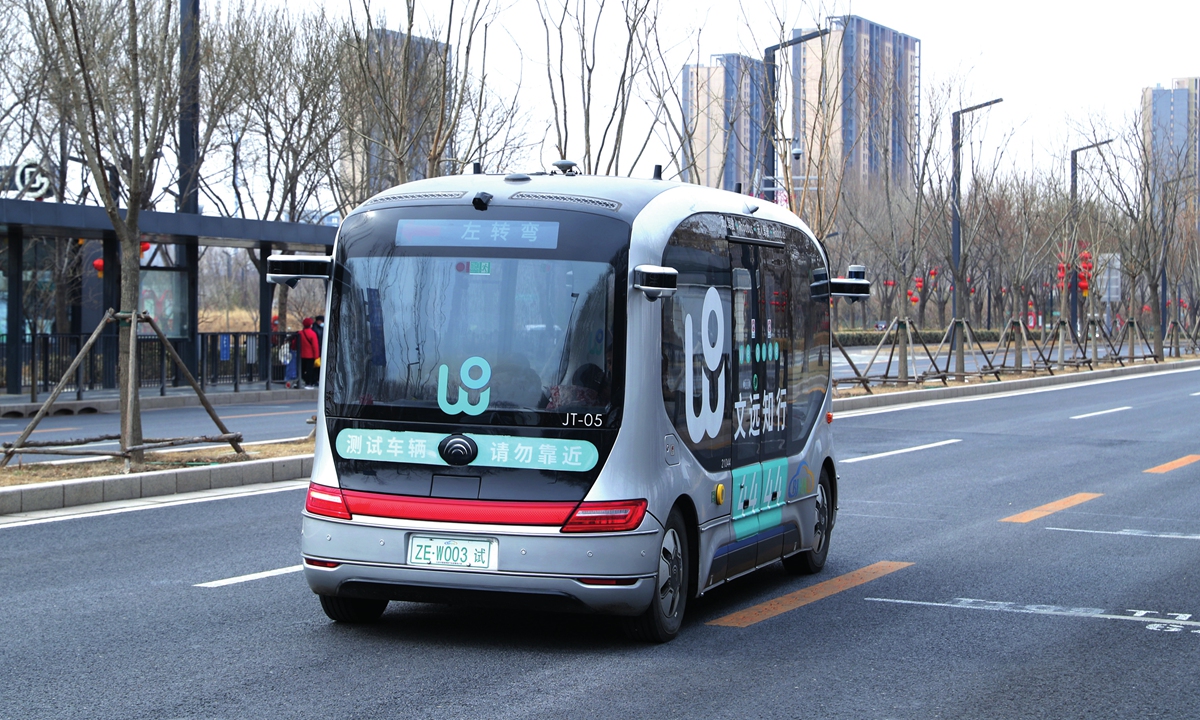
A driverless mini bus carries passengers between the Beijing Haojiafu subway station and the Beijing Library in the Tongzhou district on March 4, 2024. Beijing is permitting passengers to take free trial rides in certain areas of the district during the pilot program. Photo: VCG
Concerns about the safety of autonomous driving and the potential gradual replacement of traditional taxis by driverless ones have been raised following an accident involving a driverless ride-hailing car in central China's Hubei Province. Industry observers said the industry is still in a nascent phase and that more support needs to be rolled out to address challenges brought by the development of driverless ride-hailing vehicles.
According to media reports, a netizen posted a video on July 7 claiming that one of Baidu's autonomous ride-hailing platform Robotaxi's driverless ride-hailing cars had collided with a pedestrian on a street in Wuhan.
A representative from Baidu responded on Monday stating that there was only minor contact between the vehicle and a pedestrian evading a red light as the vehicle began to move forward. The company was the first to cooperate with the police to address the situation and accompanied the individual to the hospital for a full examination.
Autonomous driving technology can theoretically improve road safety by avoiding traffic violations through high-precision sensors and advanced algorithms. However, in practice, complex road conditions and traffic have placed high demands on the reaction speed and decision-making ability of intelligent driving systems, Zhang Xu, an Analyst from EnfoDesk, told the Global Time on Thursday.
Many challenges are actually caused by traffic violations by ordinary pedestrians and other human-driven vehicles, Zhang said calling on traffic management department to enhance the supervision and meanwhile, the development and testing of intelligent driving systems should also be strengthened to better adapt to real traffic environment.
At the same time, many local drivers in Wuhan have voiced their dissatisfaction over the potential gradual replacement of traditional taxis by driverless vehicles, according to media reports, as one of the drivers said Robotaxi offers a relatively lower price which would reduce the customer's budget for the taxi fare.
Industry observers said driverless ride-hailing cars will indeed have an impact on the traditional human operated ride-hailing and taxi industries because of relatively low operating cost and stable service performance, but this is a necessary step in upgrading of the industry.
With the development of technology and the maturity of the market, driverless ride-hailing cars will gradually replace traditional manned services, driving the entire transportation industry toward a more intelligent and automated direction, they said.
Beijing also plans to support the use of autonomous vehicles in urban transportation services, including urban public electric bus transportation, online ride-hailing, and car rental, according to Beijing Municipal Bureau of Economy and Information Technology on June 30.
Although driverless ride-hailing vehicles may reduce demand for traditional drivers, they will also create new employment opportunities, Zhang said. Maintenance and management of intelligent driving technology, data analysis and processing, development and operation of intelligent transportation systems, remote drivers, maintenance of autonomous vehicles and stations all require a large number of skilled workers, the analyst said.
Although the development of driverless ride-hailing vehicles faces challenges, with the support of policies and technological advancements, its future prospects are promising, industry observers noted.
The basic principle is that the government should formulate and strictly enforce necessary regulations to ensure the safety and compliance of driverless ride-hailing vehicles, and at the same time, efforts should be made to strengthen research and development support for the technology, and encourage enterprises to innovate and promote the application of technology.
Zhang put forward that the government should provide relevant employment training and transition support during the industry transition to help traditional drivers adapt to the new employment environment.
In response to the question of whether driverless ride-hailing cars have taken the jobs of drivers, a staff from transportation bureau in Wuhan responded that the taxi industry is relatively stable, and there are some online rumors, according to media reports on Wednesday.




